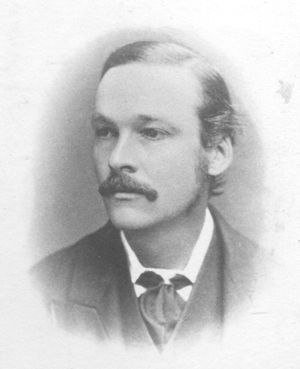Francis Maitland Balfour, FRS
 1851-1882. Professor of Animal Morphology
1851-1882. Professor of Animal Morphology
Balfour was born in Edinburgh, the fifth of the eight children (and third son) of James Maitland Balfour, landowner and MP, and Lady Blanche Gascoyne-Cecil, second daughter of James Gascoyne-Cecil, second marquess of Salisbury. The Conservative prime minister, Arthur James Balfour, was an elder brother; his sister Nora married the philosopher Henry Sidgwick.
Frank Balfour showed an early aptitude for natural history. At Harrow School he wrote a geological essay which brought him to the attention of Thomas Huxley, whose influence was to be lifelong.
Balfour entered Trinity in 1870, and won a natural science scholarship the following spring (Huxley was an examiner). Michael Foster, Praelector in Physiology, encouraged him to undertake original research on the nature of the primitive streak in chick embryos and its possible relationship to the amphibian blastopore. Thus began Balfour's pursuit of homologies between embryos of different organisms, which led to his first three papers in embryology and The Elements of Embryology (1874), co-authored with Foster.
In February 1874 Balfour was one of the first two British naturalists to work at Anton Dohrn's Stazione Zoologica in Naples, where shark and dogfish embryology was the subject of his investigations. This work brought him to the attention of the British scientific community, and he was elected natural sciences Fellow of Trinity.
As part of his efforts to establish physiology, histology, and embryology at Cambridge, Foster gave responsibility for embryology and morphology to Balfour. The latter's first lectures in embryology in July 1875 were only a modest success, and an inadequate forecast of his enormously popular lectures as lecturer in animal morphology from October 1876. During this period Balfour also continued his research work at Naples. His Monograph on the Development of Elasmobranch Fishes (4 vols., 1878) enhanced his reputation as a leading evolutionary embryologist, and led to his election as FRS at the age of twenty-six in June 1878.
Under Balfour's direction the Cambridge Morphological Laboratory became the world centre for comparative and evolutionary embryology. Although most of the research was left to his students, Balfour was not idle. He ran the laboratory, assisted by his student Adam Sedgwick, who succeeded him as director.
Balfour's work brought him much acclaim, especially after publication of the Treatise. A Royal Society medal, appointment as the youngest member of the society's council, and an honorary LLD degree from Glasgow University all came his way in 1881 and it seemed that an illustrious career lay ahead. However, despite these accolades, and the growth of animal morphology at Cambridge, the brightest new star in the biological sky, who Darwin thought would ‘one day be the first of English Biologists’, held no appointment at the university. Oxford sought him as Linacre professor of human and comparative anatomy, and Edinburgh as regius professor of natural history. Balfour was tempted by Edinburgh, which was less than thirty miles from Whittingehame, the family seat. In January 1882, however, Foster spearheaded a petition to the Cambridge senate seeking a university position for Balfour. Just weeks later, Balfour contracted typhoid. It was thought he would not live. Cambridge was finally moved to act and appointed him to a ‘Professorship of Animal Morphology terminable with the tenure of the first Professor’.
By July 1882 Balfour had recuperated sufficiently to travel to Switzerland for his favourite relaxation, alpine climbing. After testing his condition on some easy climbs, he and a guide set out on 18 July to scale Mont Blanc. Both men died on the glacier of Treyney, Courmayeur, Italy, on 19 July. Balfour was buried at Whittingehame on 5 August. Reactions to his death indicate the depth of loss felt by friends and the scientific and university communities. For Huxley the deaths of Darwin and Balfour in the same year meant the loss of ‘the best of the old and the best of the young’ (Huxley, 2.38). Cambridge established a library and a studentship in Balfour's name. The first studentship went to William Caldwell, whose discovery ‘monotremes oviparous, ovum meroblastic’, cabled to the BAAS meeting in Montreal in 1884, was a dramatic demonstration of the evolutionary embryology espoused by Balfour.
| Memorial inscription | Translation |
|
FRANCISCUS MAITLAND BALFOUR Huius Collegii necnon Societatis Regiae Socius Natus decimo die Novembris Mdcccli Ostendent terris hunc tantum fata neque ultra esse sinent |
Francis Maitland Balfour was a Fellow of the College and of the Royal Society, and was elected Professor of Animal Morphology in the University. A notable researcher into the secrets of Nature, he had already made great contributions to knowledge and would have made many more had he but lived. Born on 10th November 1851, he died young among the Alpine snows on 19th July 1882. ‘Him the fates shall but show to earth, nor longer suffer him to stay.’ [Virgil, Aeneid VI] |
Francis Maitland BalfourBrass located on the north wall of the Ante-Chapel. |

Click on the thumbnail for a larger image. |
|
|
PREVIOUS BRASS |
|
NEXT BRASS Edward White Benson |
| Brasses A-B | Brasses C-G | Brasses H-K | Brasses L-P | Brasses R-S | Brasses T-W |
